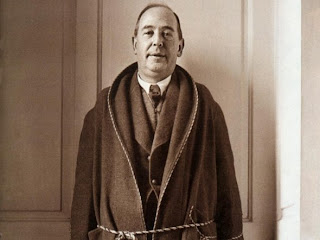
Lewis was a close friend of J. R. R. Tolkien, the author of The Lord of the Rings, and both were leading figures in the English faculty at Oxford University and in the informal Oxford literary group known as the "Inklings". Due in part to Tolkien's influence, Lewis converted to Christianity, becoming "a very ordinary layman of the Church of England". (Lewis 1952, pp. 6) His conversion had a profound effect on his work, and his wartime radio broadcasts on the subject of Christianity brought him wide acclaim. Late in life he married the American writer Joy Gresham, who died of bone cancer four years later at the age of 45.
Lewis's works have been translated into over 30 languages and continue to sell over a million copies a year; the books that comprise The Chronicles of Narnia have sold over 100 million copies. A number of stage and screen adaptations of Lewis's works have also been produced, the most notable of which is the 2005 Disney film adaptation of The Lion, the Witch and the Wardrobe.
RELIGION, CHRISTIANITY AND C.S. LEWIS

Influenced by arguments with his Oxford colleague and friend J. R. R. Tolkien, and by the book The Everlasting Man by Roman Catholic convert G. K. Chesterton, he slowly rediscovered Christianity. He fought greatly up to the moment of his conversion noting he likened himself to a, "'...prodigal who is brought in kicking, struggling, resentful, and darting his eyes in every direction for a chance to escape.." He described his last struggle in Surprised by Joy:
"You must picture me alone in that room in Magdalen, night after night, feeling, whenever my mind lifted even for a second from my work, the steady, unrelenting approach of Him whom I so earnestly desired not to meet. That which I greatly feared had at last come upon me. In the Trinity Term of 1929 I gave in, and admitted that God was God, and knelt and prayed: perhaps, that night, the most dejected and reluctant convert in all England." (Lewis 1966)

A committed Anglican, Lewis upheld a largely orthodox Anglican theology, though in his apologetic writings, he made an effort to avoid espousing any one denomination. In his later writings, some believe he proposed ideas such as purification of venial sins after death in purgatory (The Great Divorce) and mortal sin (The Screwtape Letters), which are generally considered to be Catholic teachings. Regardless, Lewis considered himself an entirely orthodox Anglican to the end of his life, reflecting that he had initially attended church only to receive communion and had been repelled by the hymns and the poor quality of the sermons. He later came to consider himself honoured by worshipping with men of faith who came in shabby clothes and work boots and who sang all the verses to all the hymns.
C.S. LEWIS AND JOY GRESHAM

Joy's cancer soon went into a remarkable yet brief remission, and the couple lived as a family (together with Warren Lewis) until her eventual relapse and death in 1960.
THE CHRONICLES OF NARNIA


 The books contain many allusions to Christian ideas which are easily accessible to younger readers; however, the books are not weighty, and can be read for their adventure, colour and richness of ideas alone. Because of this, they have become favourites of children and adults, Christians and non-Christians. In addition to Christian themes, Lewis also borrows characters from Greek and Roman mythology as well as traditional British and Irish fairy tales. Lewis reportedly based his depiction of Narnia on the geography and scenery of the Mourne Mountains and "that part of Rostrevor which overlooks Carlingford Lough". (Guardian Unlimited 2005) Lewis cited George MacDonald's Christian fairy tales as an influence in writing the series.
The books contain many allusions to Christian ideas which are easily accessible to younger readers; however, the books are not weighty, and can be read for their adventure, colour and richness of ideas alone. Because of this, they have become favourites of children and adults, Christians and non-Christians. In addition to Christian themes, Lewis also borrows characters from Greek and Roman mythology as well as traditional British and Irish fairy tales. Lewis reportedly based his depiction of Narnia on the geography and scenery of the Mourne Mountains and "that part of Rostrevor which overlooks Carlingford Lough". (Guardian Unlimited 2005) Lewis cited George MacDonald's Christian fairy tales as an influence in writing the series.The Chronicles of Narnia present the adventures of children who play central roles in the unfolding history of the fictional realm of Narnia, a place where animals talk, magic is common, and good battles evil. In the majority of the books, children from our world find themselves transported to Narnia by a magical portal. Once there, they are quickly involved in setting some wrong to right with the help of the lion Aslan who is the central character of the series.
---------------
http://www.biographyonline.net/writers/cs-lewis.html
http://www.squidoo.com/aslanspride?utm_source=google&utm_medium=imgres&utm_campaign=framebuster


No comments:
Post a Comment